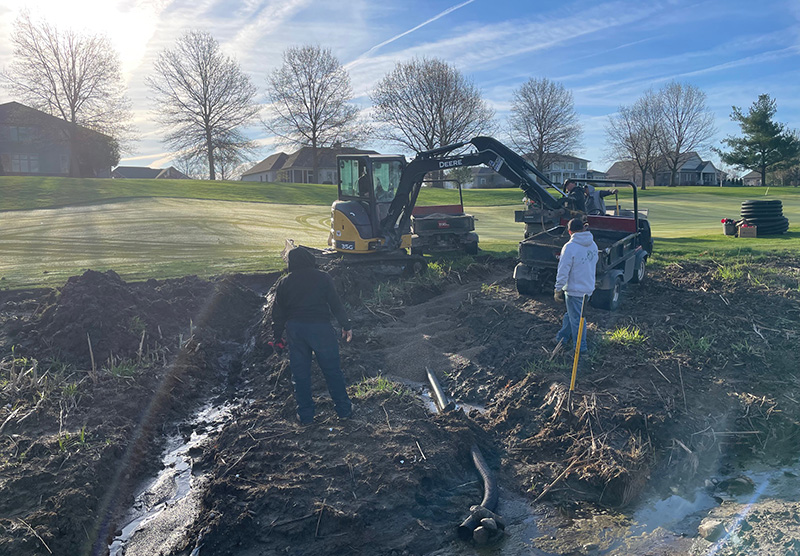
Chris Lewis, CGCS, is the GCSAA Class A director of agronomy at Landscapes Golf Management and a 22-year GCSAA member.Photos courtesy of Landscapes Golf Management
Editor’s note: The following article was supplied by Landscapes Golf Management. All product claims, research cited and other information is directly from the company.
As director of agronomy for Landscapes Golf Management, Chris Lewis, CGCS, travels the country, tours the company’s properties and shares ideas with superintendents. The 22-year GCSAA member posits it’s only natural there are differences in product quality, staff efficacy and budget performance between cultures categorized as great, good and those with room for improvement.
No one is perfect all the time, but no matter the size of the team, morale level – be it frustration, happiness or other emotions between these bookends – affects employee retention. Moreover, its contagiousness spells the difference between stellar work outputs and deleterious effects.
Culture is the optimal word, and it’s not something Lewis and his teams merely check off the list before moving on to the next duty. They must be on top of it because there’s constant change, and they must adapt accordingly, day to day, month to month and year to year. In this vein, it’s paramount to remember that people and their spectrum of attitudes represent unique creatures.
While workforce dynamics have largely shifted the past 20 years, here are five foundational, controllable tenets Lewis says successful golf course, country club and resort superintendents have in common:
Respect
Raise your crew’s self-esteem by sharing positive feelings and deferential actions. Convey a sense of admiration for valuable qualities. Golf course maintenance takes considerable time, planning and hard-nosed effort. Assembling a group of people from diverse backgrounds and life experiences, and creating a collaborative and cohesive workplace, requires respect both for a supervisor and for each other. Get your team rowing the boat in the same direction with a consistent process toward a common goal. Be willing to admit we’re all prone to occasional mistakes but that obstacles can be overcome when we treat each other equally, trust ourselves and trust each other.

Providing constructive feedback and expressing gratitude and respect for your team helps foster a supportive work environment.
Gratitude
Taking time to say “thank you” and “good job” and not following it with a “but” is worth its weight in motivational gold. Young, old, novice and experienced team members appreciate being appreciated. Whether it’s cutting cups in the correct locations, mowing straight lines across fairways or other turf-care tasks, remember that good employees quit bosses more than jobs. Lewis promises they will – without giving it a second thought – go the extra mile with over-the-top contributions upon receiving expressions of support.
Recognition
Maintenance teams conduct most of their work out of sight of golfers, relegating them to relative anonymity. Therefore, as superintendent, upon receiving compliments about course conditions, let guests know it’s a team effort, and don’t forget to share the plaudits with your team. Post employee accomplishments (with photos) on a clubhouse bulletin board or a monthly newsletter to share a team member’s extraordinary impact. Even simply introducing staff members to guests goes a long way toward winning employee productivity and loyalty.
Constructive feedback
Instead of reacting to mistakes or stressful situations with harsh criticism, find ways to make tomorrow better than today by shifting interactions with staff toward teaching moments. As a superintendent, sometimes you need to be tough when managing others, but you can communicate that in a non-accusatory tone. Your employees may not inherently possess your obsessive attention to detail; however, pointing out what to look for and how to achieve winning results will ultimately separate your golf course and management style as superior. When engaging with employees for teaching-learning exercises or serious conversations about performance, don’t conduct it – or call them out – in front of others. Politely pull them aside for a constructive one-on-one discussion, coupled with tips for improvement.

Because golf course maintenance is largely a behind-the-scenes job, Lewis suggests looking for opportunities to make your team's work known to club members and leadership.
Leadership
Calmly, collectedly and assuredly lead by example, showing you care about the team as individuals and professionals. Take the time to empathetically hear their concerns, then share recommendations based on your experiences. Lewis proclaims most superintendents (in his experience) would rather mow greens than sit in another meeting. However, you can’t always be in the field alongside your employees. That’s why checking and showing you care eases stress and helps maintain top-notch course conditions.
Lewis adds that one of the most difficult elements of the turf industry is the ability to maintain work-life balance. Make time to get away from the property, because with proper teaching, your team will feel comfortable trusting your leadership and management process, often with even more dedication in your absence.